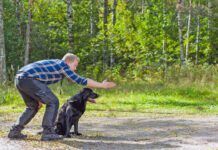When they fill out their evaluation forms at the end of a six-week course, my clients frequently name the “Off” exercise as one of the most useful behaviors they have taught their dogs in class.
“Off” means “Whatever you are paying attention to right now, I want you to leave it alone.” It can be applied to the roast on the counter, the snacks on the coffee table, the dead skunk beside the trail, the neighbor’s cat darting across the yard, or frail 93-year-old Aunt Martha. It’s one of my favorite exercises for watching a dog’s brain at work as she grasps the concept of “leave it alone.” Best of all, it’s fun and easy. You can do the exercises all in one session if your dog is an “Off” whiz, or it may take several.
ONE: Hold up a highly desirable “forbidden treat object” such as a cube of freeze-dried liver so your dog can see it. When she shows interest, say “Off!” in a cheerful tone of voice and place the object on the floor. Be sure to use a pleasant tone, not an intimidating one. You are giving her information, not scaring her away from the treat.
TWO: Quickly, before she can grab it, cover the treat with your foot. Let her dig, claw, bite, and lick to her heart’s content. Wear sturdy old shoes – do not do this with bare feet or sandals, or your shiny Sunday best. Do not repeat the “Off” cue. Just wait.
THREE: Sooner or later she will lose interest in the forbidden object, or be distracted. The instant she looks away from your foot, Click! the clicker (or say “Yes!”) and reward her with a treat of equal value from your hand. Do not feed her the treat under your foot.
FOUR: If she eats the reward and immediately goes back to digging at your foot, wait until she looks away again, then Click! and reward. Keep doing this until she is no longer paying any attention to the treat under your foot. Use a high rate of reinforcement (lots of Clicks! and treats) until she realizes that it is more profitable to “not look” at the treat under your foot.
FIVE: If she eats the reward and does not immediately go back to your foot, Click! and reward her so she quickly figures out she does not have to repeatedly try to get the object and then stop, in order to make the Click! happen. Your goal is to get her to leave it alone completely, not keep going back to it.
SIX: After several repetitions, pick up the forbidden object, show it to her again, say “Off” and place it on the floor, again covering it with your foot. Each time you start the exercise fresh by picking up the object and placing it on the floor, say “Off” one time, and only one time. Do not keep repeating the “Off” cue if she keeps trying to get it from under your foot. You want her to understand that once you say “Off!” it means forever.
SEVEN: When she seems to understand that she should leave your foot alone, uncover the treat slightly. Be prepared to cover it again quickly with your foot if she dives for it! Keep clicking and rewarding her for looking away from it, until she will leave it alone even when it is uncovered. You will be amazed by how quickly she learns this.
EIGHT: As she becomes more reliable about leaving it alone with your protector-foot nearby, gradually move farther away from the treat until you can stand three to four feet away and she still honors the “Off.” Err on the side of caution; if she grabs the forbidden object, she will have been rewarded for the exact opposite of your behavior goal. If this happens, you must back up in the program and repair the damage.
NINE: When she is reliably honoring “Off” with you standing four feet away, attach the leash to her collar, set up the “Off” with the forbidden object on the floor, and move three feet off to one side. Keep the leash just barely taut but not tight, so you can restrain her if she moves toward the treat.
Now call her to you. She should honor the “Off” cue and come to you rather than lunging forward to get the treat. When she does, Click! and Jackpot! (give a handful of treats, one by one, as an extra big reward). If she moves toward the treat, simply restrain her with the leash – don’t say “No!” or repeat “Off.” Just wait for her to give up and turn back to you. Then Click! and treat.
TEN: Now you can apply this to real life. With your dog on leash, walk past piles of treats you have laid out on the floor, or other natural enticements, such as a bowl of chips on the coffee table. As soon as she makes eye contact with the enticement say “Off” one time in a cheerful tone of voice and stand still, restraining her, with the leash short enough that she can’t reach the object. Wait until she gives up and turns back to look at you. Click! and reward.
Repeat until she understands that “Off” applies to real-life encounters. When she will reliably and routinely honor the “Off” cue without even tightening the leash, you are ready to try it off leash.
On your first off-leash attempt, use relatively boring enticements such as a pile of dry cookies, and be sure to have wonderful rewards to give her when she turns back toward you in response to your cue. Warm her up on leash, then take off the leash and give it a try. Be confident and visualize success, so you don’t pause and tense up near the item, and she’ll likely reward you with a perfect performance.
-by Pat Miller





